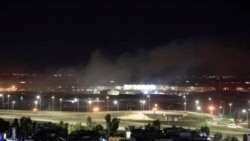On February 25, the U.S. military conducted a precision air strike on a base used by the Iranian-backed militia Kattaib Hezbollah near the town of Al Bukamal on the Syrian side of the Iraqi-Syrian border.
The strikes came in response to a series of rocket attacks on U.S. facilities in Iraq, including an attack in Erbil that left a non-U.S. contractor dead and four U.S. personnel wounded, and another rocket attack targeting the U.S. Embassy in Baghdad.
In the U.S. attack near Al Bukamal, a militia member was confirmed killed, although some sources reported as many as 17 or 22 died.
The same day, a Twitter account with over 346,000 followers called StanceGrounded (@_SJPeace_) tweeted a TikTok video purporting to show the effects of U.S. aerial bombing in Syria, with the following message:
“U.S. foreign policy in the Middle East This is Syria! For a country that doesn’t want refugees, they sure do love creating them. If you don’t want refugees, STOP CREATING THEM! AND STOP VOTING FOR POLITICIANS WHO LOVE BOMBING THE [expletive] OUT OF OTHER COUNTRIES!”
The video shows a camera panning around the ruins of what it claims is a Syrian city, and text appears on screen, reading:
“The destruction in Syria is so sad. This was when I visited in January 2021.”
It is not clear who exactly made the video. The only voice that can be heard is a female text-to-speech voice reading the on-screen text.
The video, however, presents a false impression.
In the replies to the tweet, Syrians and those familiar with the conflict quickly recognized the city as Homs, which was the scene of heavy fighting early in the Syrian civil war and is nowhere near Al Bukamal.
Homs was subjected to a brutal siege until 2014, when it fell to Assad regime forces. Many civilians fled the bombardment and reprisals by regime-loyal militias that looted the city after its fall. These siege tactics were later repeated in other major cities, most notably Aleppo, which fell to the regime in 2016.
Unlike the precision-guided munitions the U.S. military uses, the Syrian air force has been known to bomb indiscriminately and use “barrel bombs” – large metal cylinders filled with high explosives and metal fragments that are dropped from helicopters.
Despite video evidence showing the use of barrel bombs in civilian areas throughout the war, Syrian President Bashar al-Assad has denied they have been used.
The U.S. has only carried out one air strike on the city of Homs, targeting a chemical weapons facility in April 2018 in response to the chemical weapons attack in the town of Douma. A handful of other airstrikes have taken place in the Homs governorate, but they were precision-guided attacks on specific military targets.
Most of the U.S. airstrikes in Syria were conducted to support the Kurdish-led Syrian Democratic Forces in their fight against the Islamic State terrorist group, mainly in 2014-2018.
As for the recent operation in Al Bukamal, both the Iranian Islamic Revolution Guard Corps and affiliated militia targeted in the strike released photos showing the damage to their facility. The photos show the targeted area is nowhere near any urban center. The militia group also confirmed the death of one of its fighters, Rahi Salam Zayid al-Sharifi.
An estimated 6.6 million people have fled Syria since the war’s beginning in 2011. Most left fearing reprisals for having resisted the government or because their homes were destroyed by the regime’s bombing. The Assad regime and its Russian allies are responsible for the overwhelming majority of the civilian casualties in the conflict.






